Sharlyn J. Lauby's Blog, page 33
September 24, 2023
Bookmark This! Workplace Ethics Edition – The HR Bartender Show
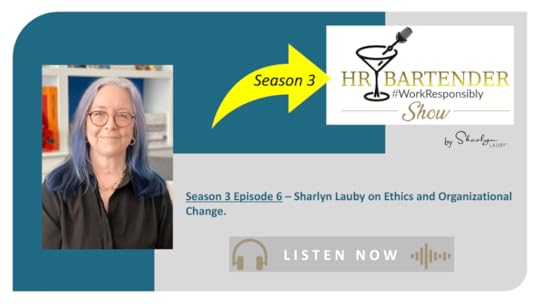
Estimated reading time: 3 minutes
In our second season of The HR Bartender Show, we focused on change management. We are constantly being faced with change. Some big, others small. Some impact our professional lives, and others on a personal level. It’s important that we know how to manage change.
That’s why I think it’s so applicable to focus season three on workplace ethics. Ethics is defined as the “moral principles that govern a person’s behavior”. In turn, workplace ethics encompass the principles that organizations use to guide their decisions and actions. Employees want to know that their ethics align with the organization. And they want to know if they have questions or concerns that the organization will listen … and investigate.
If organizations haven’t spent any time intentionally thinking about creating and maintaining an ethical culture, now’s a good time.

If you haven’t listened to the previous episodes in this season on ethics, here they are:
Dr. Martin Armstrong Defends Why Everyone “Owns” Organizational EthicsHeather Bussing Discusses the Role of HR in Ethics and InvestigationsMeric Bloch Explains the Intersection of Ethics and ComplianceDr. Christopher Bauer Talks About Ethics TrainingJakub Ficner on How Technology Can Help Organizations Manage Ethical RiskA huge thanks to this season’s guests: Jakub, Chris, Meric, Heather, and Martin. I really appreciate them sharing their experience and expertise with us. Again, I encourage you to check out their episodes and connect with them. Thank you for supporting HR Bartender! I hope you enjoy the season on workplace ethics.
During this episode, I mentioned Lewin’s 3-step model for change. Here’s some additional information about the model: https://www.hrbartender.com/2019/leadership-and-management/change-management-stop/
Season 3 Episode 6 – Sharlyn Lauby Show Notes
Season 3 Episode 6 – Sharlyn Lauby Transcript
Thanks for listening to our podcast. This season of the HR Bartender show is brought to you by our friends at Case IQ, the leading provider of modern investigative case management software to handle virtually any type of workplace incident. With millions of cases resolved, and billions of dollars in litigations avoided, trust Case IQ to help you protect your employees, your organization, and your brand.

You can subscribe to The HR Bartender show on Apple Podcasts, Spotify, Google Podcasts, TuneIn, and wherever you can listen to your favorite podcasts. And we would absolutely love it if you would leave a review.
If you enjoyed this episode, be sure to check out other episodes on our podcast page.
The post Bookmark This! Workplace Ethics Edition – The HR Bartender Show appeared first on hr bartender.
September 21, 2023
You Must Define Your Own Work Life Balance – hr bartender
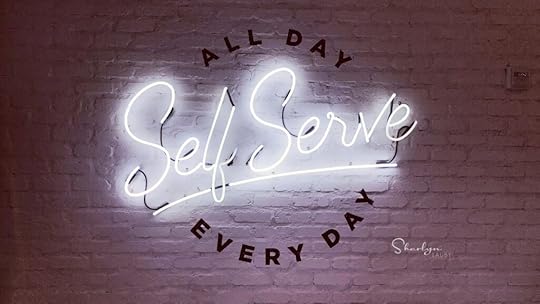
Estimated reading time: 3 minutes
I recently saw a posting in a Facebook group about work life balance. The OP (original poster) was asking about interviewing for a job in a 24/7/365 industry and whether you could have “work life balance”.
Lots of people shared their stories and many people encouraged the person to ask about work life balance during the interview. This is great advice. Regardless of whether you work in a 24/7/365 industry or not, it’s important to understand expectations when it comes to working hours.
But there were two things that I didn’t see come up in the discussion. The first is that each of us must define what work life balance means for us. We can’t assume that work life balance means Monday through Friday from 8:30a to 5:00p and every single holiday off. Maybe it does for some people, but not everyone.
I’ve worked with people who worked 10:00a to 6:00p because it allowed them to drop their kids off at school and to be available for our offices which were in a different time zone. I’ve worked with individuals who were happy to work on Easter and Christmas because they took Passover and Rosh Hashanah off. It was great that the organization and employee were able to work something out that benefitted both.
And sometimes being asked to work on a day that you haven’t traditionally worked can be an unexpected source of fun and enjoyment. One of the hotels I worked at asked the management team to work on either Christmas Eve or Christmas Day. Your choice. But since the employees couldn’t take those days off, it just seemed wrong to let every member of the management team take those days off. I know some people might find this to be “ugh” but the controller and I both chose Christmas Eve. We would dress up in costumes and hand out candy to the kids staying the hotel. It was fun. Then our families would meet us and we would have Christmas Eve dinner together. Again, not what I expected but it was nice.
Which brings me to my second point. And this has to do with our roles as human resources professionals. Once you decide what work life balance means to you, then you have to decide if that will allow you to effectively do your job.
Let’s say your version of work life balance means Monday through Friday 8:30a to 5:00p. If I’m an employee who works the overnight shift, when do I get to interact with HR? And if there’s someone else in the HR department who likes coming in early or working a weekend, then great. But HR has to think about the operation and employees they are supporting.
This isn’t to say that a person’s work life balance expectations are wrong. Work life balance is important, and it contributes to a person’s wellbeing. Unfortunately, I’ve seen people not be honest with themselves about their work life balance and end up being stressed out and burned out. So …
Define what work life balance means to you.When looking at new opportunities, understand work expectations. If you’re asking for others to be flexible, then be flexible yourself.Be realistic about whether you can do the job and maintain your wellbeing.This little list was very easy to type up. The reality is this can be a challenge. And I believe the hardest part is at the beginning. Defining work life balance is very personal. It also takes the support of family and friends. Taking the time to understand your own needs and wants is worth it.
Image captured by Sharlyn Lauby while exploring the streets of Salt Lake City, UT
The post You Must Define Your Own Work Life Balance – hr bartender appeared first on hr bartender.
September 19, 2023
Workplace Ethics [Episode 5] Jacob Ficner on Managing Ethical Risk with Technology
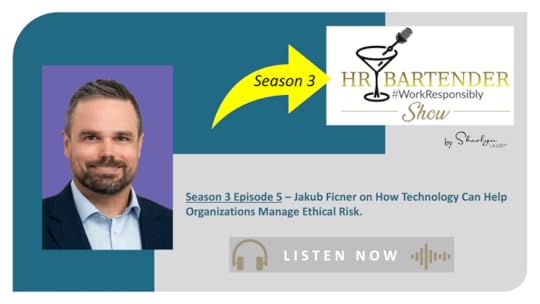
Estimated reading time: 3 minutes
Organizations want to operate in an ethical manner. They also want to be effective and efficient. There’s no reason that organizations have to compromise on doing it all.
It starts with building a good foundation of ethics. But then organizations need to think about how to maintain ethics, no different that regularly examining data and information to ensure effectiveness and efficiency.
In this episode of The HR Bartender Show, I spoke with Jakub Ficner, director of partnerships at Case IQ. In his role, Jakub specializes in investigative documentation and workflow solutions for HR, employee and labor relations, ethics, compliance, and fraud teams. He provides training and education to improve accountability and defensibility of organizations investigative processes. Jakub is a graduate of University of Ottawa and Purdue University.

What technology does well is collect data. And that’s where we can use technology to reduce ethical risk. Organizations can examine their ethics complaints and investigations to look for trends. And understanding those trends allows the organization to take steps to reduce risk.
The time to think about using technology to reduce risk isn’t when the organization has a problem – and the technology becomes a reactive solution. Using technology should be a proactive discussion that aligns with the organization’s strategy.
If you want to connect with Jakub:
Website https://www.caseiq.com
LinkedIn https://www.linkedin.com/in/jakubficner/
Twitter https://twitter.com/caseiqsoftware
I mentioned during the episode that Jakub and I have worked together on a couple of webinars. Here are links to the recordings so you can take a listen.
“5 Ways to Increase Employee Trust for Less Turnover and Fewer Incidents”
“5 Steps for Creating an Ethical Work Culture – and Expertly Responding to Incidents”
Jakub referenced a few articles during this episode. Here are the links – I hope you check them out.
“Do ethical firms create value?” by Khondkar Karim, SangHyun Suh, Jiali Tang, Social Responsibility Journal, 2016“The State of Moral Leadership in Business”, The HOW Institute for Society, New York, 2022“Striking a Balance Between Rules and Principles-Based Approaches for Effective Governance” by Surendra Arjoon, Journal of Business Ethics“The Worth of Values – A Literature Review on the Relation Between Corporate Social and Financial Performance” by Pieter van Beurden and Tobias Gössling“Increasing customer loyalty: The impact of corporate social responsibility and company image” by Graham Cole, 2017Season 3 Episode 5 – Jacob Ficner Show Notes
Season 3 Episode 5 – Jacob Ficner Transcript
Thanks for listening to our podcast. This season of the HR Bartender show is brought to you by our friends at Case IQ, the leading provider of modern investigative case management software to handle virtually any type of workplace incident. With millions of cases resolved, and billions of dollars in litigations avoided, trust Case IQ to help you protect your employees, your organization, and your brand.

You can subscribe to The HR Bartender show on Apple Podcasts, Spotify, Google Podcasts, TuneIn, and wherever you can listen to your favorite podcasts. And we would absolutely love it if you would leave a review.
If you enjoyed this episode, be sure to check out other episodes on our podcast page.
The post Workplace Ethics [Episode 5] Jacob Ficner on Managing Ethical Risk with Technology appeared first on hr bartender.
September 17, 2023
Leadership and Management Are Not Interchangeable Terms
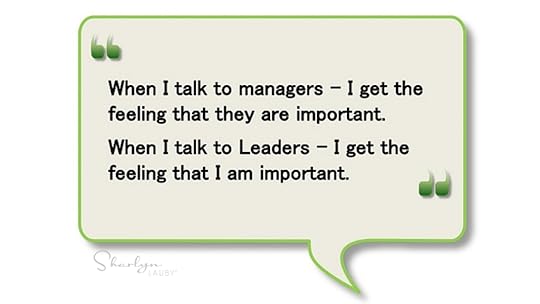
Estimated reading time: 4 minutes
Please forgive me for a bit of a rant today, but I feel compelled to write about leadership, management, and the fact that they’re different.
Management is a discipline that has five functions: planning, organizing, staffing, directing, and controlling.
Leadership is the ability of an individual to influence.
Using these definitions, everyone can be a leader. Let me say that again, everyone can be a leader. We want managers to be leaders. But not all leaders will have the job title of manager. That’s okay. Because management and leadership are not interchangeable terms. And we don’t want them to be.
More importantly, management is not secondary to leadership. And that’s the reason I wanted to write something about leadership and management. I see people using the word leader like it’s superior to the word manager. You’ve probably seen it too, but here are a couple of examples:
“For the last couple weeks, I’ve been refocusing with leaders on whether we should stay at our level, or we should play down a level (essentially doing our managers’ roles).”
“This is a leader’s toughest discipline…letting go and trusting your team.”
The perception I get from these comments is that leaders are better than managers. Leaders are above managers. And that if you’re an employee, then you have no influence on the organization. Which I hope is not true.
I love a good motivational quote as much as the next person but creating platitudes about leadership can be very harmful to individuals and organizations if they’re not presented in the right context. In essence, these quotes make it sound like only people with high level job titles are leaders. And everyone else is … well, they’re not. It can also keep organizations from developing employees with leadership skills because they’re not what is considered a leader in the organization.
It’s just like the quote in today’s image. I’m sure the person’s intent was to say that when I’m having a conversation with others, I want to feel important. There’s absolutely nothing wrong with that. We all want to feel that way. But that’s not a function of management or leadership. That’s about being a thoughtful human being and practicing empathetic listening.
Organizations need managers. The functions of management are important to business operations. We need people who can effectively and efficiently plan the work, organize the work, staff the operation, direct the work, and control resources.
Managers should be able to lead. The reason we often combine management and leadership in the same sentence is because to be a good manager, you need to be able to influence others. Managers should be able to influence the planning of work, the allocation of resources, and the direction of work.
Managers shouldn’t be the only leaders in the organization. We regularly talk about the value of employee feedback. Ideally, employee feedback should be able to influence the organization. That’s called leadership. Employees can influence the way things get done.
Employees who can influence are candidates for management opportunities. Organizations often look at employee interactions to determine if they’re ready for positions of greater responsibility. Employees who show they’re able to influence the organization could be great candidates for a supervisory skills or management development program.
Again, I think we need to be careful about using management and leadership as interchangeable terms. It could become difficult to explain performance. For example, if the organization doesn’t differentiate between leadership and management, how do you tell a manager that they’re doing a great job as a leader (but not as a manager)? Or vice versa – how do you explain to someone who does an excellent job of influencing that they’re not ready for management?
As a HR pro, saying that you’re working with the senior management team does not imply that you’re in some sort of unimportant role. We don’t need to say we’re working with the “leadership team” to be important. As HR professionals, we do need to be able to explain what leadership and management are and coach people on how to achieve their leadership and management goals.
The post Leadership and Management Are Not Interchangeable Terms appeared first on hr bartender.
September 14, 2023
Bookmark This! Second Chance Employment Edition
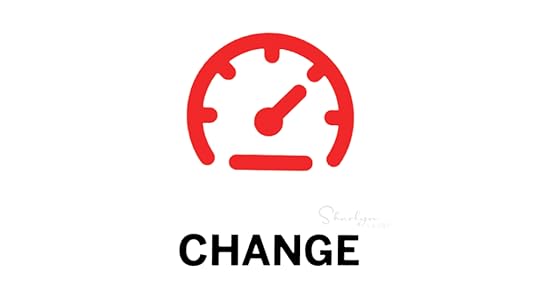
Estimated reading time: 3 minutes
According to The Sentencing Project, between 70 and 100 million people – or one in three Americans have a criminal record. And of those, only about 10 million have been incarcerated. Having a criminal record, even without a conviction, can be a huge barrier to employment.
Regardless of today’s unemployment rate, organizations are continually looking for employees who have skills and want to work. Organizations might want to consider second chance or fair chance employment as a way to find qualified candidates. Here are a few resources to get the conversation started.
If you’re trying to figure out how to sell the organization on the idea of developing a second chance strategy, check out the article “4 Reasons for Organizations to Consider Second Chance Employment”. It outlines who benefits when organizations offer second chances and shares some stories from companies that have seen positive results.
Speaking of resources, the Second Chance Business Coalition (SCBC) is a group of private sector employers committed to expanding second chance hiring. Their membership includes a wide variety of industries including financial services, retail, manufacturing, transportation, telecommunications, and technology. Their website has an interactive map with a way to identify community partners.
The Society for Human Resource Management (SHRM) offers a free certificate program called Getting Talent Back to Work. You do not have to be a SHRM member to participate in this program. This is an online, self-paced program designed to help professionals learn more about second chance employment and how to add second chance employment into your existing recruiting strategy.
I recently did a webinar with our friends at Accurate Background on “How to Build a Fair Chance Hiring Program”. We not only share resources but talk about how to overcome common objections and some steps to consider when developing your program. You can listen to the recording of the webinar on the Accurate site.
There is plenty of research that shows second chance employment programs benefit organizations and individuals. And it doesn’t increase cost per hire. In fact, the Work Opportunity Tax Credit (WOTC) is a federal tax credit available to employers for hiring and employing individuals from certain targeted groups who have faced barriers to employment.
Recruiting is going to continue to be a challenge for employers. Whether it’s finding enough candidates or finding enough qualified candidates. Organizations need to consider new strategies to keep competitive. Then take the time to develop and work these strategies to get results.
Image captured by Sharlyn Lauby while exploring the streets of Salt Lake City, UT
The post Bookmark This! Second Chance Employment Edition appeared first on hr bartender.
September 12, 2023
Workplace Ethics [Episode 4] Dr. Christopher Bauer on Training Employees to Make Ethical Decisions
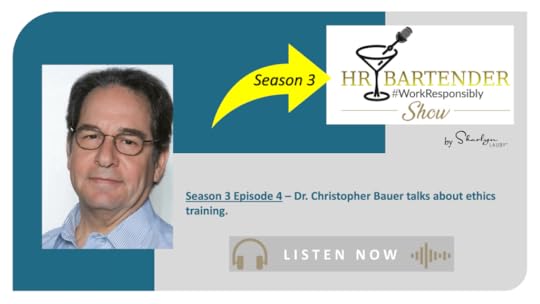
Estimated reading time: 4 minutes
When I talk about an organization’s mission, vision, and values (MVV), one of the things that I like to suggest is that the company’s stated MVV should be realistic. What I mean by that is sometimes organizations create jazzy sounding mission statements or edgy values to stand out in the crowd. It doesn’t take long for candidates, employees, and customers to figure out if an organization actually follows them.
Well, maybe it’s time to add ethics statements to the list. Because if the company’s ethics statement doesn’t realistically reflect the workforce, then the organization can be faced with a disconnect. This disconnect between what’s written and practiced doesn’t help employees make ethical decisions. And that might end up costing the company money (and talent).
It also has an impact on ethics training. In this episode of The HR Bartender Show I spoke with Dr. Christopher Bauer. He’s a clinical psychologist by training however for over thirty years he has worked as a speaker, educator, author, and consultant on professional ethics. His clients have run the gamut from small and medium sized organizations to every level of staff and management at Fortune 500 corporations.
His articles on how to build and maintain great ethics in the workplace have appeared in journals such as CEO Refresher, CFO Magazine, Financial Executive, Internal Auditor, and many other print and online publications for a wide range of professions. In addition, his keynotes and seminars have made the topic of ethics in the workplace not only fun but, more importantly, both practical and profitable for organizations around the globe.

One of the comments that Dr. Bauer made during our conversation is that “people do what’s reinforced”. Well, if the only thing that organizations do where ethics is concerned is have employees sign off on an ethics statement, that doesn’t really create the level of reinforcement necessary to maintain an ethical culture. Organizations should think about a more holistic approach to ethics – during interviews, onboarding, training, refreshers, and throughout the employee life cycle.
If you want to connect with Dr. Bauer:
Website https://www.christopherbauer.com
LinkedIn https://forms.aweber.com/form/22/1373469922.htm
Twitter https://twitter.com/ethicstweet
I mentioned during the show that Dr. Bauer publishes a free “Weekly Ethics Thought” seen by thousands of readers worldwide. And Dr. Bauer mentioned a report from the Association of Certified Fraud Examiners that mentions the cost of occupational fraud being in the range of 5-7% of the bottom-line. Lastly, here’s an article from our friends at Foley & Lardner LLP on the costs associated with employee lawsuits. The article is a few years old, but it offers some perspective – legal defense fees are not cheap. This doesn’t include the cost of replacing and onboarding the employee.
Season 3 Episode 4 – Dr. Christopher Bauer Show Notes
Season 3 Episode 4 Dr. Christopher Bauer Transcript
Thanks for listening to our podcast. This season of the HR Bartender show is brought to you by our friends at Case IQ, the leading provider of modern investigative case management software to handle virtually any type of workplace incident. With millions of cases resolved, and billions of dollars in litigations avoided, trust Case IQ to help you protect your employees, your organization, and your brand.

You can subscribe to The HR Bartender show on Apple Podcasts, Spotify, Google Podcasts, TuneIn, and wherever you can listen to your favorite podcasts. And we would absolutely love it if you would leave a review.
If you enjoyed this episode, be sure to check out other episodes on our podcast page.
The post Workplace Ethics [Episode 4] Dr. Christopher Bauer on Training Employees to Make Ethical Decisions appeared first on hr bartender.
September 10, 2023
7 Business Lessons I Learned from Writer Neil Gaiman

Estimated reading time: 4 minutes
A couple of months ago, I received an email from my cellular carrier saying they could “save me money”. I must admit that I’m usually a bit skeptical when these emails arrive but one day we were near our cellular store and decided to pop in to see if it was true. And much to my surprise, they did save us about 30% on our bill without a decrease in services. Lesson learned: sometimes it pays (literally) to investigate.

One of the other things we received in our new cellular plan was a free trial membership to MasterClass. I’m enjoying the sessions and look forward to sharing some of them with you. Like today’s with Neil Gaiman. Mr. Bartender and I are fans of the Amazon Prime show Good Omens, which is based on a book of the same name written by Terry Pratchett and Neil Gaiman. Because I’ve been enjoying the show, I wanted to listen to Gaiman’s MasterClass on Storytelling though I wasn’t specifically looking for business lessons.
While I enjoyed hearing about Gaiman’s writing and storytelling in the context of his work in the science fiction and fantasy genre, there were several things he said that are very applicable to the business world.
Stories help us tell the truth. Gaiman started the class talking about storytelling and the importance of storytelling. In the business world, we tell stories all the time – about customer successes, employees going the extra mile, and how a process should work. But how often as businesspeople do we think about the way we communicate as storytelling? Maybe it would help our business communications to think about it that way and spend time developing our skills as storytellers. Look at old things a new way. Sometimes the answer to a problem isn’t to completely disrupt the system. Sometimes the answer is simply reexamining an old process in a new way. For example, maybe taking a manual process online. The process itself doesn’t change. Where it takes place changes (online versus on paper). Have faith in the process. Regular readers of HR Bartender know I’m definitely a process person. There are so many proven processes that can help us achieve our goals. If the process works, have confidence in it. If it doesn’t work, check out business lesson #2 above and look at it in a new way. Know what you want. It’s perfectly okay to be in the middle of figuring out what you want. But keep in mind that one reason problems don’t get resolved is because people and/or organizations don’t know what they want. For instance, a person might say that they have several different options for a career path. That’s great. But instead of saying “any of them will do”, there’s probably one that’s preferred. Don’t be afraid to communicate what you would prefer. Anticipate the conflict and deal with it. In business, we have to sell our ideas. In putting our thoughts together, it helps to anticipate the objections and know how to respond. Organizations do this too. For example, when the company knows they’re making a decision that will be unpopular with customers or employees, they have to think about the objections and be prepared to deal with them. Help your audience. Gaiman mentioned that sometimes in writing books, the author must remind readers about something that happened fifty pages earlier. And it’s the author’s job to figure out how to help the audience remember these things so they still enjoy the book. I must admit, I’m not sure we do this enough in business. Are there ways we could help our stakeholders remember things without doing the “don’t you remember six months ago…” line (which might come across as condescending)? Learn from your failures. And let me add your successes. Whether you do it individually or as part of a team activity, conduct a quick debrief. Ask two questions: What did I do well? And what could I do differently next time? You will learn a lot and be able to apply those learnings in the future. It might even focus you on having a better sense of what you want (see #4).There’s one more business lesson that I took from Neil Gaiman’s MasterClass. He mentioned that he learns a lot from genres different from his own. He talked about learning from music and art. That’s one of the other reasons I wanted to share my takeaways with you. Just because we’re businesspeople doesn’t mean we have to exclusively read business books or listen to business podcasts. In fact, maybe it would make us better if we didn’t.
Image captured by Sharlyn Lauby
The post 7 Business Lessons I Learned from Writer Neil Gaiman appeared first on hr bartender.
September 7, 2023
Workplace Inclusion: Organizations Must Choose to Take Action
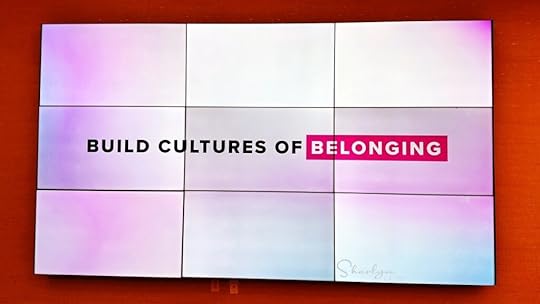
Estimated reading time: 5 minutes
According to a LinkedIn study, 76% of candidates and employees say that diversity is important when considering job offers and 80% said that they want to work for an organization that values DE&I (diversity, equity, and inclusion). There are also several studies that show how companies that place an emphasis on DE&I outperform their competition.
However, these outcomes are predicated on organizations not simply talking about diversity, equity, and inclusion but also doing something about it. That’s why I wanted to chat with Michael Bach, who is an expert in the areas of diversity, equity, and inclusion (DE&I). Michael has been recognized globally as a thought leader in the DE&I space and is the author of two books “Birds of All Feathers: Doing Diversity and Inclusion Right” and “Alphabet Soup: The Essential Guide to LGBTQ2+ Inclusion at Work”.
Michael, welcome to HR Bartender. I always like to start conversations like ours with a definition. Tell us how you define inclusion?
[Bach] I see inclusion as a state of being. An inclusive space – be it a place of work, a place of learning, a place of healing – is one where a person can be their whole self in; where the things that make them ‘different’ (aka their diversity) are not hindrances to being in that space.
As an example, as a member of the LGBTQIA+ community, there are many states right now that are not safe for me because of the 700+ pieces of anti-LGBTQIA+ legislation that have been tabled or passed this year so far. Florida is the ultimate example: I do not feel safe in Florida, and therefore, I do not feel included in Florida. Inclusion is an aspirational state that we should all be working toward.
Let’s talk about inclusion at work. How can HR convince the organization that diversity and inclusion are two different things?

[Bach] This is a bit difficult because it’s fundamental to the conversation. Diversity is about the things that make us different, and inclusion is about being in spaces where I can be different without fear of repercussion. To put it more simply, diversity is a fact – it has always existed and will continue to exist. We are all diverse in some way (but we are not all underrepresented and marginalized). Inclusion is a choice. We can choose to create inclusive spaces, or we can choose to create exclusive spaces. The choice is ours. State Legislators in Florida are choosing to be exclusive.
What do organizations get right when it comes to creating more inclusive workplaces? And what do they still need to work on?
[Bach] Where I give organizations points right now is that they get that they have to do something. Most organizations I’ve worked with recognize that change must happen because their current state isn’t working.
Where they’re not succeeding is in recognizing that diversity and inclusion isn’t a ‘program’. There’s a LOT of performative action happening. We see pride flags in June and Black History Month celebrations in February, but that doesn’t affect change. People are still Black in March, April, and May (and obviously every day of the year), and they’re facing anti-Black racism every day of the year. Where organizations fail is in not recognizing that we need systemic change.
From an organizational perspective, who should be accountable for inclusion?
[Bach] That’s easy: Leadership. Tone from the top is crucial when it comes to diversity, equity, and inclusion (DE&I). If leadership doesn’t buy in, then you’ve failed before you’ve begun. As the saying goes, ‘What’s important to my boss is important to me’. But even more importantly, if leadership doesn’t take ownership of the DE&I agenda, then you can and will really struggle to make progress. If an organization’s leadership is being held accountable for DE&I, then it will get done!
Last question. Often HR is very active in DE&I activities. If HR pros could do one thing to improve their understanding of inclusion, what would it be?
[Bach] HR professionals must accept that they are the product of the same systems as everyone else. The same is the case for DE&I professionals. We are not free of bias. But I’ve lost count of the number of times when HR professionals feel they’re ‘better’ than most when it comes to DE&I. I hear CHROs say, “My HR team doesn’t need the training because they ‘get it’.” Wrong!
HR professionals need the training more than anyone. We are at the frontline of this effort. So, the one thing that HR professionals need to do to improve their understanding of inclusion is to be open. They need to accept that they are just as flawed as everyone else. They need to get uncomfortable. They need to be on a constant journey of learning and seek out information to help improve their understanding. There is no endpoint in that journey. There is only more journey.
I want to extend a huge thanks to Michael for sharing his knowledge with us. If you want to learn more about inclusion, be sure to check out Michael’s website.
Also, if you specifically want to learn more about how to measure the results of your inclusion efforts, Michael will be speaking at this year’s Society for Human Resource Management (SHRM) Inclusion conference. The conference will be held in Savannah, Georgia on October 29 – November 1, 2023. Registration details can be found on the SHRM website. And Michael’s session will be available in-person and virtually.
Michael’s comment about leadership and accountability really resonated with me because I believe that leadership is defined as “the ability to influence others”. Which means that everyone is a leader, and everyone is accountable for inclusion. Yes, senior management needs to set the tone and approve the resources, but everyone is responsible. If we want more inclusive workplaces, we have to be a part of the solution.
Image captured by Sharlyn Lauby while exploring the streets of San Diego, CA
The post Workplace Inclusion: Organizations Must Choose to Take Action appeared first on hr bartender.
September 5, 2023
Workplace Ethics [Episode 3] Meric Bloch: Ethics and Compliance are Two Different Things
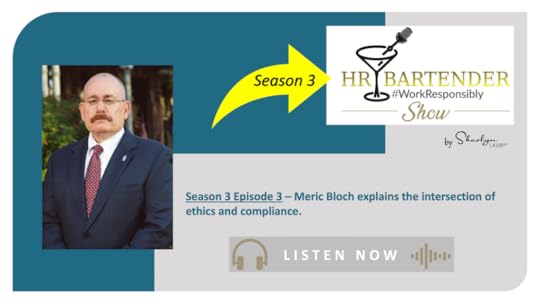
Estimated reading time: 4 minutes
One of the biggest challenges that organizations have is after investing the time and resources into developing a code of conduct and designing ethics training, stuff still happens. As a human resources professional, we might say to ourselves, “Why? Didn’t employees read the standard? Didn’t people pay attention during training?” And the answer might be that we’re not doing a good job of drawing the distinction between ethics and compliance.
Compliance involves company expectations. It could be compliance with a law, or an agreement like a union contract, or maybe compliance with a company rule. Compliance matters might change over time as laws, agreements, or rules change. If someone violates the law, agreement, or rule, they are non-compliant.
Ethics are the values and moral principles we live by – both in our personal and professional lives. And they rarely change. When we talk about ethics and compliance, it’s possible to be non-compliant, but still ethical. It’s also possible to be non-compliant and unethical.
The challenge for organizations is to bring ethics into compliance standards. We’d like to think we all know what ethical behavior looks like. And what compliance looks like. But maybe we’re not doing enough to explain it, including using real examples into ethics and compliance training. That’s why I’m excited to share with you this episode of The HR Bartender Show.
Meric Bloch is the strategic advisor for Winter Investigations. His experience includes roles as an ethics and compliance officer for three multinational Fortune 500 companies and a healthcare system. He has designed, implemented, and managed each company’s workplace investigations process worldwide.
Meric has personally conducted over 800 internal investigations of fraud and serious workplace misconduct in the U.S., Europe, and Asia. He developed the “Winter Method” for workplace investigations and has trained thousands of HR and compliance professionals. He is the author of three books on investigations: “Workplace Investigations: Techniques and Strategies for Investigators and Compliance Officers”, “Investigative Interviewing”, and “The First Information Is Almost Always Wrong”.

One of the things I appreciated about my conversation with Meric was the WIIFM (What’s in it for me?) when it comes to ethics and compliance. Organizations might say to themselves, “I get it. But I’m under pressure to deliver results.” And that’s exactly the reason that organizations need to think about the connection of ethics to the business. It’s not just about doing the right thing. Organizations that do not operate ethically or in a compliant way can hurt their brand, their products and services, and ultimately the bottom line.
If you want to connect with Meric:
Website https://winterinvestigations.org
LinkedIn https://www.linkedin.com/in/mericbloch/
Season 3 Episode 3 – Meric Bloch Show Notes
Season 3 Episode 3 – Meric Bloch Transcript
Thanks for listening to our podcast. This season of the HR Bartender show is brought to you by our friends at Case IQ, the leading provider of modern investigative case management software to handle virtually any type of workplace incident. With millions of cases resolved, and billions of dollars in litigations avoided, trust Case IQ to help you protect your employees, your organization, and your brand.

You can subscribe to The HR Bartender show on Apple Podcasts, Spotify, Google Podcasts, TuneIn, and wherever you can listen to your favorite podcasts. And we would absolutely love it if you would leave a review.
If you enjoyed this episode, be sure to check out other episodes on our podcast page.
The post Workplace Ethics [Episode 3] Meric Bloch: Ethics and Compliance are Two Different Things appeared first on hr bartender.
August 31, 2023
There Are Only 3 Reasons to Hold Business Meetings
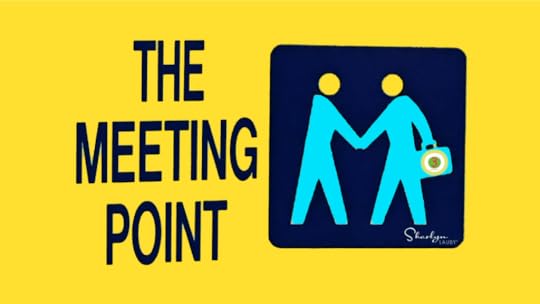
Estimated reading time: 4 minutes
Just in case you missed it, Zoom recently announced that they were discontinuing the practice of “no meeting Wednesdays” at their offices. Yep, despite studies that show “no meeting days” were very popular and resulted in greater employee productivity, Zoom decided to stop the practice. Not exactly sure why … but it does make me wonder.
Business meetings are the bane of our professional lives. I recently saw an article on LinkedIn saying that about 30% of our time is in meetings. That’s a pretty significant number. Some companies are trying to reduce the amount of time spent in meetings by attaching rules or guidelines to them. For example, the Zoom practice of abolishing meetings on Wednesdays. I can’t help but think they’re in essence saying, “Schedule the meeting on a different day.” Meaning, they really aren’t impacting the amount of time in meetings. They’re just taking one day off the meeting schedule.
These rules or guidelines don’t fix the real issue. The way to fix the problem with business meetings is to run better meetings. Starting with the reason a meeting should be scheduled in the first place. The definition of meeting is “a coming together of two or more people, by chance or arrangement.” People will still get together to accomplish stuff. That’s a meeting. I’ve never heard a person complain about a meeting that was essential. Granted they might complain about the way it was conducted. We can save that discussion for another day. But as a general rule, people do not complain when the reason for scheduling the meeting is legit. And they will always complain if the meeting was called and could have been handled with an email.
In my experience, there are only three reasons to hold a meeting.
The first reason to hold a meeting is to provide information. Those regularly scheduled department meetings are a perfect example. The purpose of those meetings is to provide information. The reason they’re so dreaded is because, even when there’s nothing to convey, the meeting still happens.Same with networking meetings. These are useful, valuable opportunities that participants should covet. Despite what someone says, those synergy calls when one person talks the entire time are not networking meetings. They’re really sales presentations.
Brainstorming meetings are another type of meeting designed to provide information. Brainstorming often gets a bad rap because people use the time to also evaluate ideas, which is contrary to the whole brainstorming concept.
The second reason to hold a meeting is to make decisions. One of the most important decision making business meetings is strategic planning. The organization is developing their goals and direction. Other types of decision making meeting are pitch meetings, where individuals or organizations are pitching their ideas and project meetings, where groups are tasked with accomplishing a goal or task. The last reason to hold a meeting is to allow for feedback and discussion. Before you ask, I do view feedback a bit different than information. Feedback is a reaction to a product or performance used to ultimately create improvement. The first type of feedback meeting that comes to mind is the focus group. Whether it’s internal or external, focus groups are completely about providing feedback.Employee coaching meetings are another form of feedback meeting. It can be to tell an employee they’re doing well or to share concerns. But it’s a meeting. There’s also training meetings. When training is done properly, it’s about creating a safe environment where individuals can learn, practice, and receive feedback.
We’re not going to eliminate business meetings. But that doesn’t mean we have to attend bad ones. One of the best skills to have as a working professional is the ability to run a good business meeting. Employees who have this skill will be able to gather groups and engage their talents. The first step is knowing when to call the meeting.
Image captured by Sharlyn Lauby while exploring the streets of Fort Lauderdale, FL
The post There Are Only 3 Reasons to Hold Business Meetings appeared first on hr bartender.
Sharlyn J. Lauby's Blog
- Sharlyn J. Lauby's profile
- 10 followers



